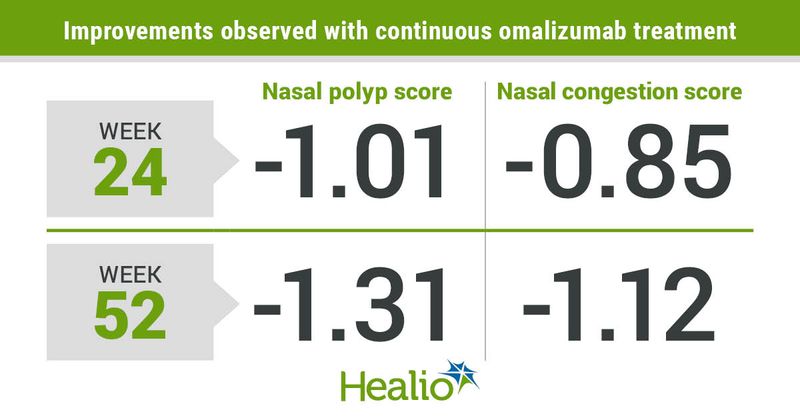Extended omalizumab treatment improves chronic rhinosinusitis with nasal polyps outcomes
Click Here to Manage Email Alerts
Extended use of omalizumab up to 1 year showed efficacy for the treatment of uncontrolled chronic rhinosinusitis with nasal polyps, according to long-term results published in The Journal of Allergy and Clinical Immunology.
Chronic rhinosinusitis with nasal polyps (CRSwNP) can often remain uncontrolled despite standard-of-care treatment with nasal corticosteroids, systemic corticosteroids, nasal irrigation, antileukotrienes, antibiotics, aspirin desensitization, nasal antihistamines or surgery, according to Philippe Gevaert, MD, PhD, professor in the department of otorhinolaryngology at Ghent University in Belgium, and colleagues.

Previously published phase 3 studies, POLYP 1 and POLYP 2, showed that treatment with omalizumab (Xolair; Genentech, Novartis), a humanized monoclonal anti-IgE antibody, significantly reduced nasal polyp size and improved symptoms among patients with CRSwNP and inadequate response to nasal corticosteroids.
Gevaert and colleagues designed an open-label extension study to evaluate the efficacy, safety and durability of response to omalizumab among 249 patients (mean age, 50.8 years; standard deviation, 12.5 years; 64.3% men) who completed the POLYP studies. Most patients completed the open-label study (95.6%) and treatment-free follow-up period (92.8%).
Patients initially randomly assigned to omalizumab in the POLYP studies continued the treatment for 28 weeks, totaling 52 weeks of treatment (n = 124). Patients initially receiving placebo in the POLYP studies received omalizumab for 28 weeks (n = 125). Omalizumab dose ranged from 75 mg to 600 mg by subcutaneous injection every 2 to 4 weeks based on serum total IgE levels and body weight, which were measured before treatment began during the POLYP studies.
Researchers withdrew omalizumab during the 24-week follow-up period, during which all patients continued daily 200 g or 400 g doses of background nasal mometasone furoate.
Gevaert and colleagues observed continued changes from week 24 baseline (end of the POLYP studies) to week 52 in nasal polyp score (–1.01 to –1.31) and nasal congestion score (–0.85 to –1.12) among patients who received omalizumab from the start.
Patients who switched from placebo to omalizumab during the extension study also showed improvement in nasal polyp score (–0.19 to –0.31) and nasal congestion score (–0.97 to –0.99).
Although nasal polyp and nasal congestion scores worsened during the treatment-free 24-week follow-up period, both scores remained lower than before treatment with omalizumab.
At week 76, nasal polyp score was 0.54 for continued treatment patients and 0.48 for those who switched from placebo. The nasal congestion score was 0.65 for continued treatment patients and 0.58 for those who switched from placebo.
Researchers also reported improvements among the continuous treatment and switch groups in secondary endpoints, including postnasal rip, runny nose, sense of smell and Total Nasal Symptom Score.
During the study, patients experienced 278 nonserious adverse events and 10 serious adverse events. One patient withdrew due to pruritus. Other common treatment-related adverse events were injection site reactions such as bruising, pain and inflammation.
“Results from this study reinforce and extend the findings of previous trials showing that omalizumab is a viable longer-term alternative treatment for patients with CRSwNP with inadequate response to nasal corticosteroids,” Gevaert and colleagues wrote.
